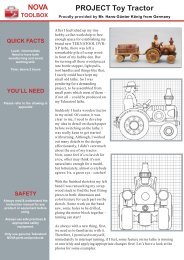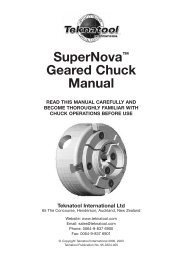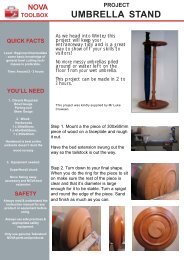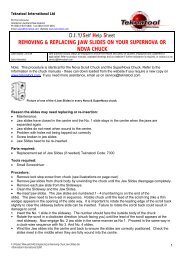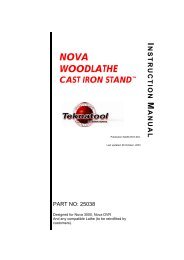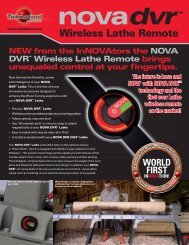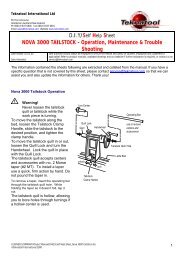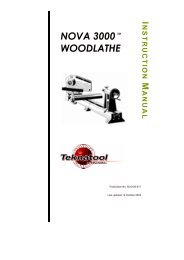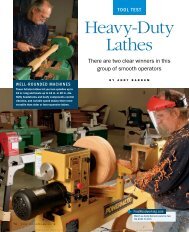You also want an ePaper? Increase the reach of your titles
YUMPU automatically turns print PDFs into web optimized ePapers that Google loves.
At 81 Ibs., the Fisch weighs slightly more than the average midi-latheweight of 74 Ibs. It has the lowest price of the bunch. And, at 15 in., itties for the most distance between centers without a bed extension. Theon/off switch is conveniently located in the headstock.one was put to work in my once-a-week, all-day class for an entiresemester. As the semester progressed, the student testers providedplenty of candid feedback on the strengths and weaknesses ofeach, machine. Here’s what we found.Power isn’t a problemAnyone taking a quick look at these small <strong>lathes</strong> might be temptedto dismiss them as less-than-serious machines. So right off thebat we wanted to know if they have enough power. And within a- few weeks, after turning an assortment of bowls, plates and spin-’ dles, the students concluded that they do. The %-hp motors, a sizethat’s often standard on larger (12-in.) <strong>lathes</strong>, provided all the musclewe needed.Dial-a-speed is simplerLathes are designed to run at severalspeeds to accommodate different sizedworkpieces. Large, heavy workpiecesrequire a slow speed, while small, lightparts can be spun considerably faster.So it’s helpful to be able to changespeeds without a lot of annoyance.IThe Nova stands out from the othersin this regard. Thanks to a d.c. motor, athree-step pulley and variable-speedcontrol, the Nova has an overall speedrange of 140 rpm to 5,350 rpm. Dependingon the pulley location, thelathe can be set to slow (140 rpm to1,750 rpmj, medium (320 rpm to 3,670rpm) or fast (470 rpm to 5,350 rpm).The medium speed range took care ofalmost all of our needs. And becauseL . ,1 ,,.r:”4. I70 FINE WOODWORKINGthe belt setting was rarely changed, speeds were varied simply byturning a dial.The Delta, Fisch, General and Jet have six speeds each (see thecharts for more specs). To change speeds, the motor must first beraised and then a V-belt shifted to the appropriate position on astep pulley. While the procedure isn’t a major headache, it fallsshort of the simpler Nova system. Also, the small belts on all ofthese <strong>lathes</strong> made belt tensioning a bit fussy. If it’s too loose, thebelt could slip; if it’s too tight, the belt could strain the bearings.Cast-iron parts make a beefier machineA lathe should feel solid and steady during the turning process. Excessivevibration or movement can interfere with tool control and,A plywood baseadds support, Tomake sure thesemachines don’tmove around whilein use, it’s a goodidea to bolt the feetto a piece of plywood,then clampthe plywood to thebench. The onlylathe not eager towander was the General.Its large. - . softrubberkeep itfeet helpedin place.Photos, this page (top) and facing page (bottom): Tom Begnal?p



